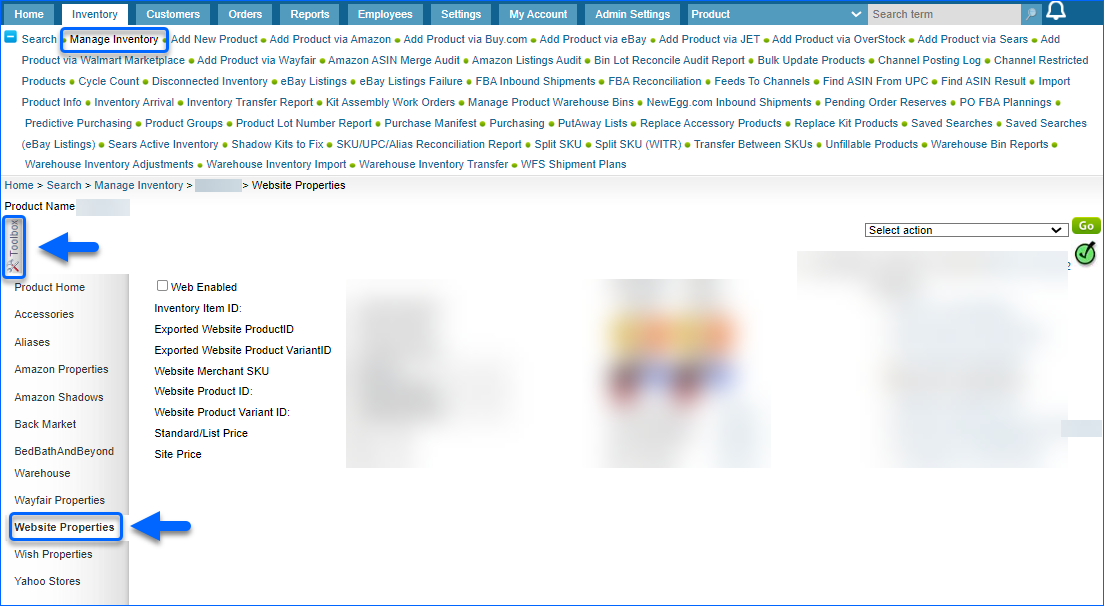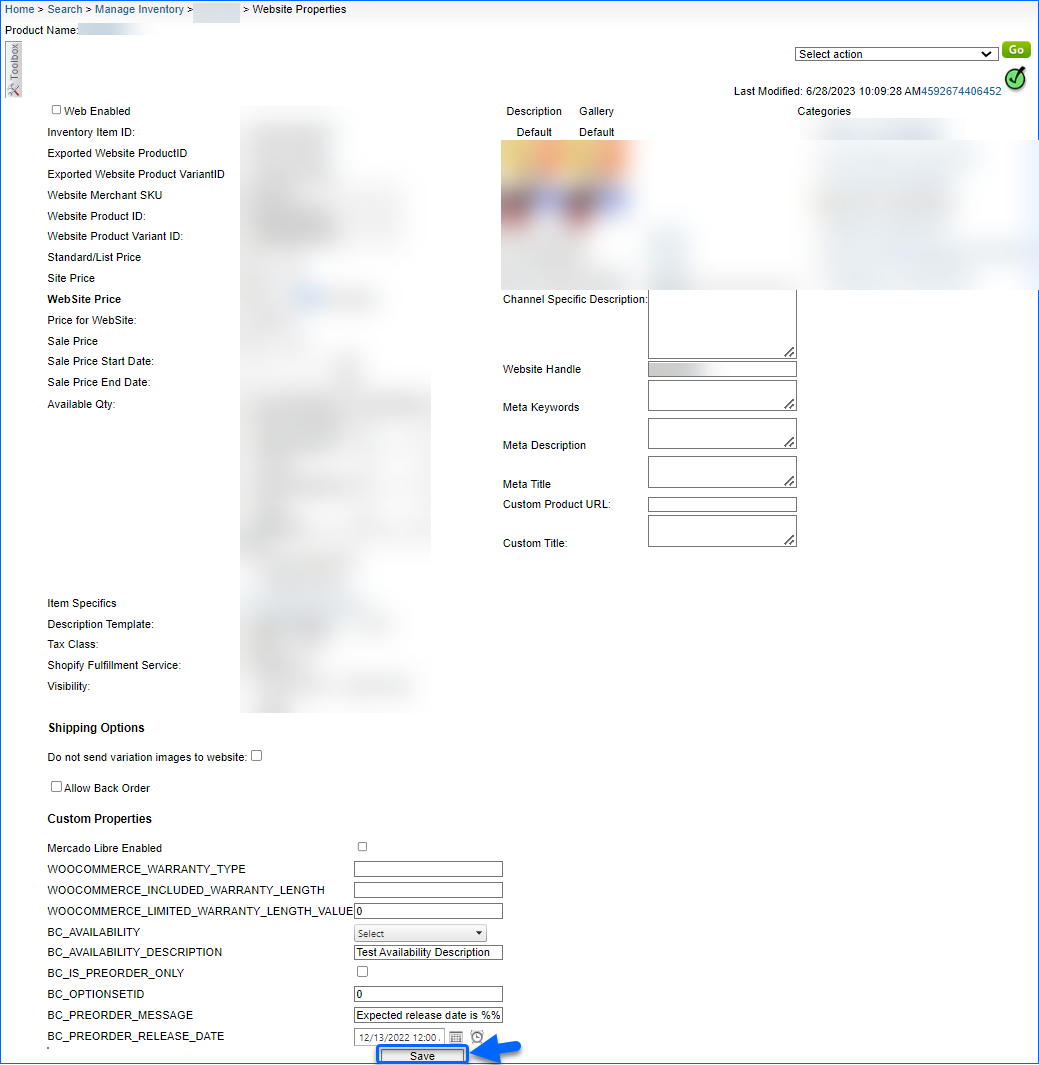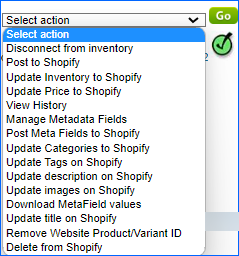Overview
The Shopify Product Properties page in Sellercloud enables you to seamlessly manage the data of your Shopify listings. Integrating your Sellercloud account with Shopify allows you to configure various product attributes and metadata, view inventory, define prices, and more. Once configured, you can update your listings.
This article describes all available Shopify Product Properties in Sellercloud and includes links to related articles for more information. To explore other related topics, refer to our Shopify Category.
Shopify Product Properties
To access the Shopify Product Properties:
- Navigate to Catalog > Manage Catalog > Search.
- Open a product > Click Toolbox.
- Select Website Properties.
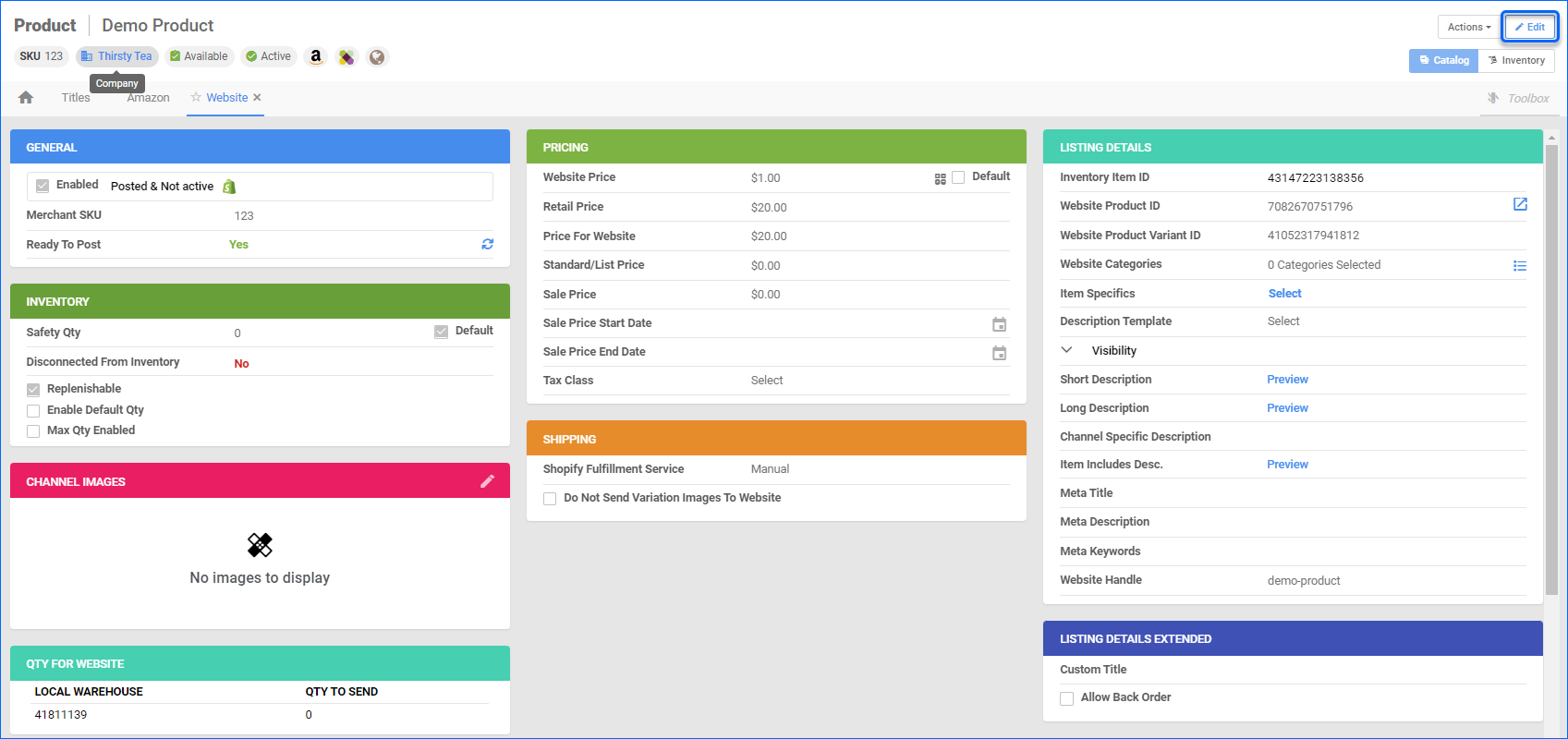
General
| Field | Description |
| Enabled | By enabling the product for Shopify, you allow Sellercloud to send regular inventory and price updates to Shopify. |
| Merchant SKU | Use this field if the product SKU in Shopify does not match your Sellerclou Product ID. |
| Ready to Post | Yes or No. When No, hover over it to see a tooltip listing all the unconfigured details required for posting the product on Shopify. |
Inventory
| Field | Description |
| Safety Qty | The Safety Quantity is subtracted from the Available Qty to prevent overselling. This amount won’t be included in the inventory feed.
|
| Disconnected From Inventory | This field indicates whether the product is Disconnected From Inventory. When Yes, Sellercloud will not send any quantities to the channel, and the last quantity sent will remain on Shopify. You can control this with the Disconnect/Reconnect from Inventory action. |
| Replenishable | Check this box to mark the SKU as Replenishable. This is typically used for products that are consistently restocked or tend to restock quickly. It keeps your listings active and prevents you from missing out on potential sales, especially for fast-selling products. |
| Enable Default Qty | When checked, it displays a Default Qty field and Default checkbox. The Default Quantity only applies to Replenishable products. For these SKUs, the default quantity is the amount that will always be sent to the channel in inventory updates, regardless of the actual available stock. Check the Default box to use the Company’s Website General Settings Default Qty. |
| Max Qty Enabled | Enables a Maximum quantity to be sent to Shopify regardless of the total available quantity. |
Pricing
| Field | Description |
| Website Price | The price of the product that will be sent to Shopify. You can set a default website price, which will use the site/retail price instead. |
| Retail Price | The retail price mirrors the Site Price from the product home page. |
| Price for Website | This informs you what the product price will be in the next product price update. |
| Standard/List Price | The price of the online listing. |
| Sale Price | An advertised product sale price. |
| Sale Price Start Date | A date for the Sale Price to begin. |
| Sale Price End Date | A date for the Sale Price to end. |
| Tax Class | The Tax Class is based on the store’s location. You can add Tax Class options in Settings > Client Settings > Tax Class. We only send this field with the Post to Website action. |
Listings Details
| Field | Description |
| Inventory Item ID | A unique identifier generated by Shopify when a SKU is posted. This is used in the Inventory feeds sent to the website. |
| Website Product ID | Your Shopify-specific Listing ID. Generated by Shopify. |
| Website Product Variant ID | This is a unique identifier used to link products and variants to their corresponding listings. It is generated by Shopify. |
| Website Categories | These are the Categories under which the product will be listed on Shopify. |
| Item Specifics | Once set, these will be displayed under your listing’s description, giving buyers information about the listing in an easy-to-read format. Read more about Item Specifics. |
| Description Template | You can choose one of your reusable templates and ensure you give your clients consistent information across listings. Read more about Description Templates. |
| Visibility | You can choose to show your product in the online store or physical store or hide it. Read more about Shopify Product Visibility. |
| Short Description | A short text to describe your product for Shopify. If none is entered, it will default to Sellercloud Product Name. |
| Long Description | A detailed description for Shopify. If none is entered, it will default to the Long Description on the Product Details page. |
| Channel Specific Description | You can use this field to override the product description sent to Shopify when listing/updating the product. |
| Item Includes Desc. | This description briefly describes what the item consists of. |
| Meta Title | This is an HTML attribute used in Shopify to determine the title of a webpage. It appears in the browser tab, search engine results, and social media posts. |
| Meta Description | In Shopify, meta descriptions provide a brief overview of the store’s content, which can help improve its visibility in search engine results. |
| Meta Keyword | Meta Keywords are a specific type of meta tag that appears in a web page’s HTML code and tells search engines what the page’s topic is. |
| Website Handle | This is a unique identifier assigned to each Shopify store. It is typically a combination of letters, numbers, and/or words and is used to identify the store in the Shopify admin. |
| UPC For Channel |
You can use this field to configure a Shopify-specific UPC. |
Shipping
| Field | Description |
| Shopify Fulfillment Service | You can set the product fulfillment as Manual or Custom. If this is not configured, we send Manual by default. |
| Do not Send Variation Images to Website | When enabled, the product images for the Variation children will not be sent to Shopify. Instead, Sellercloud will only send the image of the parent item. |
Channel Images
This panel allows you to upload, store, and easily sync product images between Sellercloud and Shopify. You can also upload images in bulk, edit existing ones, and add tags for easier organization.
Qty For Website
Inventory for Shopify is managed per Location. This panel displays the current inventory levels in each mapped warehouse.
| Field | Description |
| Local Warehouse | This field displays the local warehouses’ names that are mapped to a Shopify Location. |
| Qty to Send | This field displays the number of units available in the corresponding warehouse. |
Listing Details Extended
| Field | Description |
| Custom Title | This allows you to customize the title of your listing in Shopify. You can create unique titles to help your store’s homepage stand out in search engine results. If left empty, Sellercloud will use the Product Name. |
| Allow Back Order | When enabled, the product can be purchased on Backorder. This allows you to process and ship orders even if the item is out of stock. This setting is useful if you have many customers and want to maximize your sales by offering items that may not be in stock at the time of the order. |
Custom Columns
You can create Custom Columns for your Products to store information that doesn’t fit into the existing Sellercloud fields. You can configure their values on the Website Product Properties page, via a file import, or from the product Toolbox page Manage Custom Columns.
Manage Shopify Product Properties
You can configure the Shopify Properties of your products individually and in bulk.
Individually
To update the product website properties of a single SKU:
- Navigate to Catalog > Manage Catalog > Open a Product.
- From the Toolbox > select Website Properties.
- Click Edit in the upper-right corner.

In Bulk
To bulk update Shopify product properties:
- Go to Catalog > Tools > Import Product Info.
- Select Bulk Product Update.
- Click on Generate Template.

- A pop-up modal will appear.
- Click on Create New Template.
- Choose your desired format from CSV, tab-delimited, or Excel, and click Next.
- Select the fields you want to update from the Add Columns to Template dropdown and click Next.

- Click Download.
- Populate the Template.
- Go back to Sellercloud.
- Select the template and click Upload.

Actions
To access the Shopify Actions menu:
- Navigate to Catalog > Manage Catalog > Open a product
- From the Toolbox > select Website Properties
- In the upper-right corner, click Actions.

| Action Name | Description |
| Post to Website | This action allows you to send product information to Shopify. You can use it to create a new listing or update an existing one. With Post to Website, you can ensure that all of your product data is up-to-date and accurate. |
| Update Inventory to Website | This action syncs your product’s stock levels with Shopify’s inventory. It ensures that your customers receive accurate, up-to-date information about product availability. |
| Update price to Website | This action allows you to update the prices of your products on Shopify without having to wait for the automatic updates to resume. |
| Manage Metafield | This allows you to manage the meta fields associated with an item or product. Meta fields are name/value pairs of custom data associated with an item or product. |
| Post Meta Fields to Shopify | If you have changed the Metadata for your product, this action allows you to send an update to Shopify and sync the information between the two platforms. |
| Update Categories to Shopify | If you have changed the Category for your product, this action allows you to send an update to Shopify and sync the information between the two platforms. |
| Update Tags on Shopify | If you have changed the Tags of your product, this action allows you to send an update to Shopify and sync the information between the two platforms. |
| Update Description on Shopify | If you have changed the Description of your product, this action allows you to send an update to Shopify and sync the information between the two platforms. |
| Update Images on Shopify | If you have changed the Images of your product, this action allows you to send an update to Shopify and sync the information between the two platforms. |
| Download MetaField values |
Allows you to download all of the metadata associated with the active listing, including any custom Metafields that have been added. |
| Disconnect from Inventory | This action will disconnect the item from automatic inventory updates. If a SKU is already disconnected, the action becomes Reconnect to Inventory. |
| Update Listing Part to Website | This action allows you to do a partial update of your Shopify listings. You can select Categories, Description, Images Only, Inventory Cost, Metadata, Titles, or Variation Images. |
| Remove Website Product/Variant ID | This action removes the Website ProductID and Variant ID associated with the product. It is useful if you want to relist an item or if the current IDs are outdated. |
| Delete from Shopify | This is used to remove a product from the Shopify platform. This can be useful if you need to delete a product that is no longer available or for any other reason. |
| Restrict/Unrestrict For Channel | Use this action to temporarily Restrict any information for that product to be sent to Shopify. This includes automatic Inventory and Price updates or even posting on Shopify. |
| Preview Description Template | Performing this action opens a new tab where you can see a full preview of the selected Description Template with all of the relevant information and images included. |
Bulk Actions
Some Shopify-related product actions are also available to perform in bulk. To access the bulk actions:
- Navigate to Catalog > Manage Catalog > Search.
- Select products from the results grid > click the Actions menu icon.
- Choose an action. Once you have done this, Sellercloud will generate a Queued Job to process the request.

The available Bulk Actions are:
-
Launch on Channel… – This action allows you to create multiple new listings at once.
-
Enable/Disable For Channel… – This action allows you to update the Enabled status for Shopify of multiple products at once.
-
Update Inventory on Channel – Allows you to manually push an inventory update for the selected SKUs.
-
Update Prices on Channel– Allows you to manually push a price update for the selected SKUs.
- Update Listing Part on Website – This action allows you to do a partial update of your Shopify listings. You can select Categories, Description, Images Only, Inventory Cost, Metadata, Titles, or Variation Images.
-
Export Channel Missing Information… – Generates a file containing the fields you must configure in order to Prepare the selected SKUs for posting on Shopify.
-
Update Images On Channel – Allows you to manually push an update of product images for the selected SKUs.
- Export Channel Info… – Allows you to export the Shopify Meta-Fields of the selected SKUs.
-
Restrict/Unrestrict For Channel – Controls whether your selected SKUs are Restricted for Shopify.
-
End Listing On Channel… – This action allows you to end listings on Shopify. The SKUs in Sellercloud will have the status Not Posted.
Once you choose an action, a pop-up window will appear where you must select Website. These actions can send information to Shopify only for products created under Shopify-enabled companies.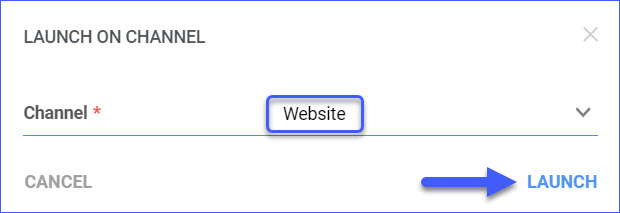
Overview
The Shopify Product Properties page in Sellercloud enables you to seamlessly manage the data of your Shopify listings. Integrating your Sellercloud account with Shopify allows you to configure various product attributes and metadata, view inventory, define prices and more. Once configured, you can accurately and efficiently update your listings.
This article describes all of the available Shopify Product Properties in Sellercloud and includes links to related articles for more information. To explore other related topics, refer to our Shopify Category.
Shopify Product Properties
To access the Shopify Product Properties, navigate to Inventory > Manage Inventory > Open a product > Toolbox > Website Properties.
General Settings
| Field | Description |
| Web Enabled | Once enabled, Sellercloud will send inventory and price updates to Shopify. Products that are not Shopify-enabled will be considered to have zero quantity. |
| Inventory Item ID | A Unique identifier will be sent to the Shopify Inventory feed. Generated by Shopify. |
| Website Merchant SKU | Shopify-specific SKU used when importing orders, sending inventory updates, etc. |
| Website Product ID | Your Shopify Specific Listing ID, generated by Shopify. |
| Website Product Variant ID | This is a unique identifier that is used to link products and variants to their corresponding websites. Generated by Shopify. |
| Standard/List Price | The price of the online listing. |
| Site Price | Mirrors the Site/Retail Price from the product home page. |
| Website Price | The price of the product that will be sent to Shopify. You can set a Default website price, which will use the site/retail price instead. |
| Price for WebSite | This informs you how much will be the product price on the next product price update. You can enable Custom Price Calculation to be displayed. |
| Sale Price | An advertised product sale price. |
| Sale Price Start Date | An advertised product sale price. |
| Sale Price End Date | A date for the Sale Price to end. |
| Available Qty | Local Warehouse column displays the specific warehouses that hold qty for the item. They need to be mapped to a Shopify Location for the quantity to be included in updates. Qty to Send column displays the number of units available in the corresponding warehouse. Custom Inventory Calculation can be enabled. |
| Enable default Qty | Displays a Default Qty field and Default checkbox. Default quantity only applies to Replenishable Products. For these products, the default quantity is the amount that will always be sent to the channel in inventory updates, regardless of the actual available inventory. |
| Enable Max Qty | Enables a Maximum Quantity to be sent to Shopify, regardless of the warehouse quantity. |
| Item Specifics | Once set, these details will be displayed under your listing’s description, giving buyers information about the product in an easy-to-read format. Read more about Item Specifics. |
| Description Template | You can choose one of your reusable templates and ensure that you give your clients consistent information across listings. Read more about Description Templates. |
| Tax Class | The Tax Class depends on the store’s location. |
| Shopify Fulfillment Service | You can set the product fulfillment as Manual or Custom. |
| Visibility | You can choose to show your product in the Online Store or Physical Store or Hide it for the moment. Shopify allows hiding an active listing for physical stores, but it should always be included for online sales. |
| Description Default | Displays the main product Description image in your Spotify listing. To manage the selection, click on the image field. |
| Gallery Default | Displays Gallery image to appear in the search results on Spotify. To manage the selection, click on the image field. |
| Short Description | Describe your product in a few words. |
| Long Description | Give your product a more detailed representation. |
| Item Includes
Description |
This description briefly describes what the item consists of. |
| Channel Specific Description | Customize your product description for each individual sales channel. |
| Website Handle | Customize your product description for each individual sales channel. |
| Meta Keyword | This is a unique identifier assigned to each Shopify store. It is typically made up of a combination of letters, numbers, and/or words and is used to identify the store in the Shopify admin. |
| Meta Description | Meta Keywords are a specific type of meta tag that appear in the HTML code of a web page and tell search engines what the topic of the page is. |
| Мeta Title | In Shopify, meta descriptions are used to provide a brief overview of the store’s content, which can help improve visibility in search engine results. |
| Custom Product URL | This is an HTML attribute used in Shopify to determine the title of a webpage. It appears in the browser tab, search engine results, and social media posts |
| Custom Title | A unique web address specifically created for a product’s Spotify listing. |
Shipping Options
| Field | Description |
| Do not Send Variation Images to Website | When enabled, the product images for the variation items will not be sent to Shopify, and Shopify will display the product image of the parent item instead. |
| Allow Back Order | When enabled, this will allow you to process and ship orders even if the item is out of stock. This setting is useful if you have a large number of customers and want to maximize your sales by offering items that may not be in stock at the time of the order. |
Custom Columns
You can create Custom Columns for your Products to store information that doesn’t fit into the existing Sellercloud fields. You can configure their values on the Shopify Product Product Properties page, via a file import, or from the product Toolbox page Manage Custom Columns.
Manage Shopify Product Fields
You can configure the Shopify Properties of your products individually and in bulk.
Individually
To update the product properties individually:
- Navigate to Inventory > Manage Inventory > Choose a Product.
- Open product’s Toolbox > Select Website Properties.
- Edit the required details and Save your changes.
In Bulk
To Bulk Update Shopify Product Properties, go to:
- Inventory > Manage Inventory > Select Bulk Update Products.
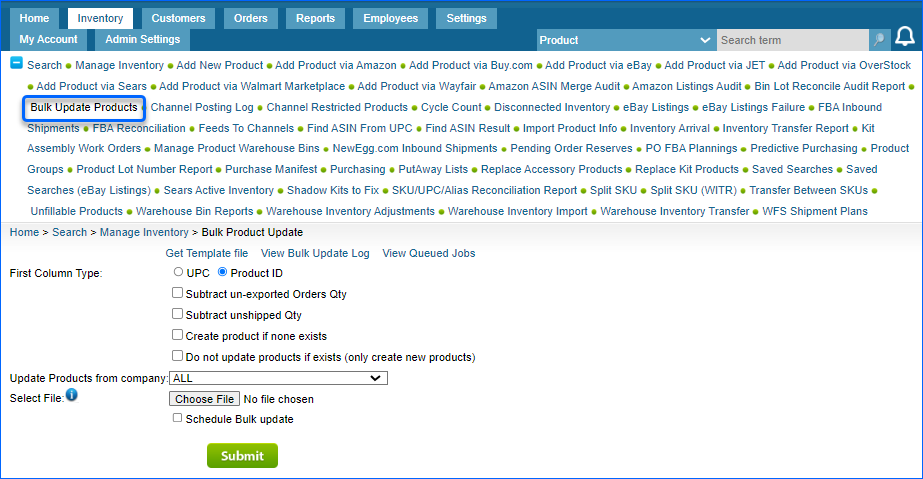
- Click on Generate Template.

- A pop-up will appear.
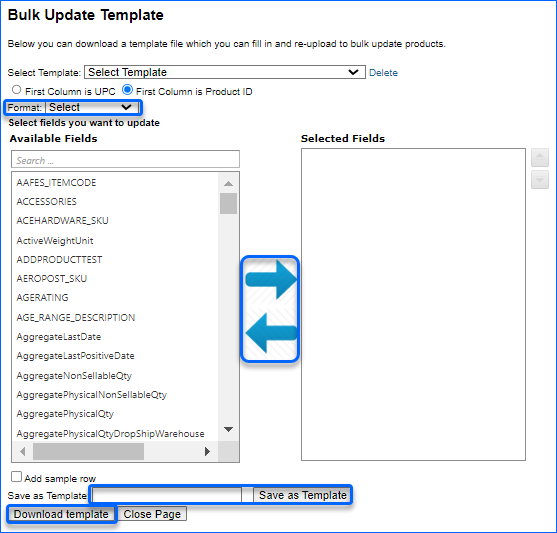
- Choose your desired format from CSV, Tab-delimited, or Excel.
- Use the arrows to select the fields that you want to update.
- Enter a Template name and click Save as Template.
- Click on Download template.
- Populate the newly downloaded template.
- Go back to Sellercloud, choose your completed template and Submit.
A Queued job will be created and can be reviewed on your Manage Queued Job page.
Actions
Sellercloud offers Product Actions and In Bulk Actions to manage your Shopify listings.
Product Actions
To access the Product Action menu, go to Inventory > Manage Inventory > Open a Product > Toolbox > Website Properties > Select action > Go.
| Action Name | Effect |
| Disconnect from Inventory | This will disconnect an inventory item from your Shopify store. This action will remove the item from the store, but it will not delete the item from Sellercloud. The item will remain in Sellercloud but will no longer be associated with your Shopify store. |
| Post to Shopify | This action allows you to make a product listing on Shopify. It can be used to create a new product listing, or it can be used to update existing product listings. With this action, you can ensure that all of your product listings are up-to-date and accurate. |
| Update Inventory to Shopify | This action syncs the stock levels of your product with Shopify’s inventory. This ensures that your customers receive accurate, up-to-date information about the availability of your products. |
| Update price to Shopify | Allows you to update the prices of your product on Shopify. This action is usually used when you want to update the prices of your products on Shopify without having to wait for the automatic updates to resume. |
| View History | With this action, you can display the history log of your product changes. |
| Manage Metadata Fields | This allows you to manage the meta fields associated with an item or product. Meta fields are name/value pairs of custom data associated with an item or product. |
| Post Meta Fields to Shopify | If you have changed the Metafields for your product, perform this action to send an update to Shopify and sync the information between the two platforms. |
| Update Categories to Shopify | If you have changed the Category for your product, perform this action to send an update to Shopify and sync the information between the two platforms. |
| Update Tags on Shopify | If you have changed the Tags of your product, perform this action to send an update to Shopify and sync the information between the two platforms. |
| Update description on Shopify | If you have changed the Description of your product, perform this action to send an update to Shopify and sync the information between the two platforms. |
| Update images on Shopify | If you have changed the Images of your product, perform this action to send an update to Shopify and sync the information between the two platforms. |
| Download MetaField values | Allows you to quickly and easily download all of the metadata associated with the active listing, including any custom Metafields that have been added. |
| Update Title on Shopify | The action allows you to update the title of your product listings on your Shopify website.. |
| Remove Website Product/Variant ID | This action removes the Website ProductID and Variant ID associated with the product. It is useful if you want to relist an item or if the current IDs are outdated. |
| Delete from Shopify | This is used to remove a product from the Shopify platform. This can be useful if you need to delete a product that is no longer available or for any other reason. |
Bulk Actions
Some Shopify-related product actions can be performed in bulk – go to Inventory > Manage Inventory > Check the required Products > Select Action > Go. Once done, Sellercloud will send information for the selected products to Shopify.
The available Bulk Actions are:
- Launch on Channel
- Enable/Disable For Channel
- Update Inventory on Channel
- Update Images on Channel
- Update Prices on Channel
- Export Channel Missing Information
- Export Channel Category Suggestions
- Export Listed on Channel
- Update Images On Channel
- Export Channel Info
- Export Products
- Export Product Images
- Export Product Notes
- Restrict/Unrestrict For Channel
Once you choose any of the above-mentioned actions, a pop-up window appears, where you can choose Channel: Website and then click on Continue.
A Queued job will be created and can be reviewed on your company’s Queued Job page.
